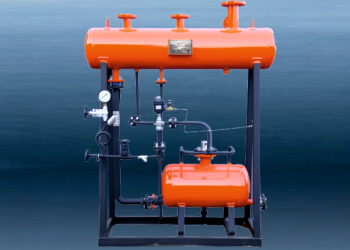Introduction
Condensate Recovery Units are widely used in various industries, including power generation, chemical processing, pharmaceuticals, food production, and HVAC applications. However, a significant amount of energy is often lost when steam condenses into water, known as condensate. Instead of allowing this valuable resource to go to waste, Condensate Recovery Units (CRUs) are employed to collect, process, and return the condensate to the boiler system for reuse. CRUs play a crucial role in improving energy efficiency, conserving water, reducing chemical treatment costs, and maintaining steam system stability. By recovering condensate, industries can significantly lower their fuel consumption and operating expenses while minimizing their environmental footprint. Additionally, modern CRUs integrate advanced technologies such as self-modulating controls, flash steam recovery, and IoT-based monitoring, making them more efficient and reliable than ever.
Key Functions of Condensate Recovery Units
Energy Savings
- When steam condenses into liquid, it still retains a large portion of the energy initially used to produce it.
- CRUs capture this condensate and return it to the boiler, reducing the need for additional fuel to heat fresh water.
- This leads to lower fuel consumption and improved overall system efficiency.
Water Conservation
- Steam systems require a continuous supply of fresh water, which must be heated and treated before use.
- By recovering condensate, CRUs reduce the demand for fresh water, thereby conserving a critical resource.
- This also helps industries meet sustainability and environmental compliance standards.
Chemical Savings
- Water in a steam system is chemically treated to prevent scaling, corrosion, and microbial growth.
- Since condensate has already been treated, reusing it minimizes the need for additional chemical dosing.
- This lowers the overall cost of boiler operation and reduces environmental impact.
Pressure Management
- Steam pressure fluctuations can cause inefficiencies, affecting heating processes and increasing energy losses.
- CRUs help maintain consistent pressure by effectively managing condensate return and preventing steam loss.
- This results in stable operation, improved performance, and reduced downtime.
Types of Condensate Recovery Units
Pumped Recovery Systems
- Used in applications where condensate must be moved over long distances or against gravity.
- Equipped with mechanical or electric pumps to transport condensate back to the boiler.
- Ideal for systems with low-pressure steam where gravity return is insufficient.
Gravity Return Systems
- Utilize natural gravity flow to return condensate to the boiler feed tank.
- More suitable for low-rise buildings or applications where steam traps are positioned higher than the boiler.
- Simple in design, requiring minimal maintenance and no additional energy for pumping.
Flash Steam Recovery Units
- Convert high-temperature condensate into reusable flash steam, reducing energy waste.
- The recovered steam is redirected to other heating processes, maximizing energy utilization.
- Highly beneficial in industries where steam is continuously required for different applications.
Unique Information About Condensate Recovery Units
Flash Steam Utilization
- Up to 80% of the energy in condensate remains in the form of flash steam.
- Instead of letting this steam escape, modern CRUs capture and redirect it to preheat feedwater or power low-pressure processes.
- This dramatically enhances energy efficiency and reduces boiler load.
Cavitation Prevention
- Pumps used in condensate recovery are prone to cavitation (formation of vapor bubbles due to pressure drops).
- Advanced CRUs integrate deaerators and air separators to eliminate dissolved gases and prevent damage to pumps.
- This extends the lifespan of system components and reduces maintenance costs.
Self-Modulating Systems
- Traditional condensate recovery systems operate at a constant rate, leading to inefficiencies during variable steam loads.
- Newer CRUs feature self-modulating controls that adjust the return rate based on steam demand.
- This ensures optimal energy usage and prevents overflow or underutilization of condensate.
Corrosion Reduction
- Condensate contains dissolved gases like oxygen and carbon dioxide, which can cause corrosion.
- Modern CRUs are made from corrosion-resistant materials like stainless steel or are coated with special protective layers.
- This ensures longevity and reliability in harsh operating conditions.
Waste Heat Integration
- Some condensate recovery systems are integrated with heat exchangers to transfer residual heat to process fluids.
- This recovered heat can be used for water preheating, space heating, or other industrial applications.
- It significantly improves overall plant efficiency and reduces dependency on external heating sources.
Smart Monitoring
- IoT-enabled CRUs are equipped with sensors to monitor flow rate, temperature, and efficiency in real time.
- Data is transmitted to a central control system, enabling predictive maintenance and early fault detection.
- This technology reduces downtime and ensures optimal system performance.
Conclusion
Condensate Recovery Units are indispensable in steam-based industrial applications, offering numerous benefits such as energy savings, water conservation, reduced chemical usage, and improved system reliability. By efficiently collecting and reusing condensate, CRUs help industries lower fuel consumption, reduce operational costs, and enhance sustainability. With advancements in technology, modern CRUs incorporate smart monitoring systems, corrosion-resistant materials, and waste heat integration, making them more adaptable and efficient. These improvements ensure that steam systems operate with minimal losses and maximum energy utilization, ultimately leading to increased productivity and environmental responsibility. As industries strive to improve efficiency and reduce costs, investing in a high-quality condensate recovery system becomes a strategic decision. Whether used in power plants, refineries, HVAC systems, or food processing facilities, CRUs provide long-term benefits by enhancing system performance and reducing energy waste.

